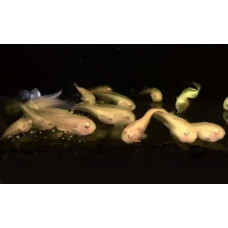Latin name
Careproctus rastrinus
Identification
The body of the Salmon snailfish is massive, high anteriorly, laterally compressed, and gradually tapering toward the caudal fin. The head is short, with a short, blunt snout. The body profile is evenly rounded. The anterior profile of the snout is vertical. The interorbital space is broad, almost three times the eye diameter; the cheeks are vertical, and the jaws are equal. The nostril is a short tube situated at the level of the lower margin of the eye. The mouth is wide, with the maxilla extending to a vertical line passing slightly behind the eye. The teeth are stout, blunt, simple, and arranged in 13 oblique rows on each side of the jaws. Vertebrae: 62-67. The pelvic sucking disc is small; in adults, it is triangular with a broad base, while in juveniles it is indistinct. The anus is located close to the disc. The head and body are densely covered with spinules.
Features of Fish Fins
Dorsal spines (total): 0; Dorsal soft rays (total): 57-62; Anal spines: 0; Anal soft rays: 50-55.
The origin of the dorsal fin is slightly anterior to the gill slit. The caudal fin is broad, slightly rounded, and connected to the anal fin for slightly more than half its length; the dorsal and anal fins do not form a notch upon merging with the caudal fin. The pectoral fin has a deep notch; the upper lobe extends backward beyond the origin of the anal fin; the lower lobe consists of 8 well-separated rays, the longest of which reaches the origin of the anal fin and is nearly equal to, or slightly shorter than, the head length.
Fish Coloration
The coloration of the living Salmon snailfish is pale, yellowish-pink, almost white on the belly and the ventral side of the head; the peritoneum is silvery.
Distribution
Distributed in the Northeast Pacific: the Sea of Okhotsk and the Sea of Japan, the Tatar Strait, and the Pacific Ocean off Hokkaido and northern Honshu, Japan. Also found in the western Bering Sea.
Habitat
A marine, deep-water species. Depth range: 55 to 913 m.
Size
Maximum recorded length for males is 51.0 cm.
Behavior
The salmon snailfish exhibits a parasitic relationship with king crabs (such as Lithodes, Neolithodes, Paralithodes, and likely Echidnocerus). They are not host-specific, but rather utilize various king crab species. A single individual red king crab (Paralithodes camtschaticus) can even carry the eggs of more than one Careproctus species simultaneously.
Food and Feeding Habits
In the wild, this fish species feeds on bottom-dwelling invertebrates. The elongated rays of its pectoral fins act as a sensory organ involved in locating food.
Reproduction
Prior to spawning, the female Salmon snailfish develops an elongated ovipositor tube, which she uses to deposit her egg mass into the branchial chamber of a crab, forming a well-protected and ventilated mobile "nest." Within this chamber, the eggs remain in complete safety and develop under oxygen conditions that are particularly favorable for embryogenesis.
Fishing
This species is not commercially important.
Relationship with a person
Harmless.
| Classification | |
| Phylum | Chordata |
| Class | Actinopterygii |
| Squad | Perciformes |
| Family | Liparidae |
| Genus | Careproctus |
| Species | C. rastrinus |
| Features | |
| Conservation status | Not Evaluated |
| Habitat | Bottom |
| Life span, years | No information |
| Maximum body weight, kg | No information |
| Maximum length, cm | 51 |
| Sailing speed, m/s | No information |
| Threat to people | Not edible |
| Way of eating | Bentophage |
Salmon snailfish
Tags: salmon snailfish

